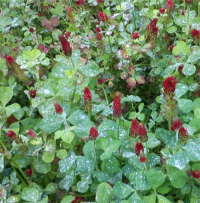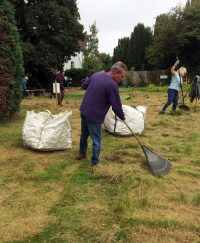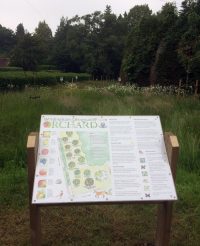
Green manures like this crimson clover can feed a bare patch of land waiting for cultivation, and prevent nutrients being lost or washed away.
The growing season is upon us and the Committee on Climate Change is encouraging us all to do our bit to encourage biodiversity, reduce carbon emissions, chemical and plastic pollution.
OUT: petro chemical based flower, food and lawn fertilisers, spot and systemic pesticides
IN: more spaces for wildlife, green manures, plant based pesticides, companion planting
We at LAWE (Looking After Woldingham’s Environment) are excited to see how many nature based solutions we can add to our organic tool kit. And we would like to share the following links with you, in case you also find some fresh ideas on perennial problems.
1. Healthy Soil
Everything starts with healthy soil. It’s important to stop using any chemicals as they leach with water far from where you first applied them, depleting life in the ground, endangering birds and small mammals as well as any pets who chomp on the treated grass or plants. Avoid digging and compaction, make sure the earth is always covered and that moisture is constant.
For details, look to Garden Organic:
• ‘To feed the soil, and improve its structure, use bulky materials like garden compost, rotted manures or leaf mould. These materials release nutrients slowly, improve soil conditions, and stimulate essential microorganisms.
• Growing green manures is another organic technique for soil improvement.
• Liquid feeds (like comfrey tea – it stinks but it works: https://horticulture.co.uk/comfrey/tea/) can help your plants in times of stress, mycorrhizal fungi improve root nutrition uptake and worms will sort out your soil
• If you don’t already, try the No-Dig method which uses thick mulches to suppress weeds.’ Why break your back digging when you can rely on the worms to drag the mulches down in to the soil, fertilising and aerating it at the same time, leaving you to get on with something else. www.gardenorganic.org.uk/expert-advice/garden-management/soil/managing-your-soil
2. Ecouraging Biodiversity
Four really easy ways of doing this are:
• Give your lawn an early mow and then leave it to grow until July/August. Mow some paths through it and a couple of areas where your table and chairs are. It’s quite surprising how many flowers appear, which pollinators come to enjoy in an instant and how many birds come to feed on the extra grubs and creepy crawlies that make it their home. In 2021 participants of Plantlife’s No Mow May campaign reported: ‘over 250 plant species including wild strawberry, wild garlic and a dazzling array of rarities including adders’ tongue fern, meadow saxifrage, snake’s head fritillary, and eyebright. Wild orchids including the declining man orchid, green-winged orchid, southern and northern marsh orchid, and bee orchid lit up liberated lawns … Lawns are sometimes considered to be wastelands for wildlife but Plantlife today illuminates that, under the right management, they can be biodiversity hotspots; EFC surveyors recorded almost 100 species of pollinators on their lawns in 2021, including 25 types of moth and butterfly and 24 types of bee including the scarce moss carder bee.’ www.plantlife.org.uk/uk/about-us/news/no-mow-may-dawn-of-a-new-british-lawn
• If moss is your lawn problem and you don’t fancy a meadow, how about creating a velvety soft moss lawn? According to the Oxygen Project: ‘A small moss lawn can absorb more carbon than 275 mature trees. It can also produce a ton of oxygen, requires significantly less water than grass, absorbs air pollutants and prevents soil erosion and runoff. www.theoxygenproject.com/post/moss-lawns-saving-the-planet-one-yard-at-a-time/
• Leave a wild patch in your garden, furnish it with old logs, a variety of dead material, twigs, dry stems, cones, add a bug hotel and hedgehog house. More ideas at: www.wildlifetrusts.org/actions/how-grow-wild-patch-or-mini-meadow
• If you don’t already have one, dig a wildlife pond – no fish, filters or pumps, just some oxygenating plants and see who discovers and sets up home there. Here’s how: www.surreywildlifetrust.org/act-wildlife/helping-wildlife/wildlife-ponds
3. Natural Fertilisers
• Home made compost, a mix of vegetable matter, grass, carbon from cardboard, regularly turned.
• And nettle or comfrey tea both make excellent natural fertilisers: www.gardenorganic.org.uk/expert-advice/garden-management/pests-and-diseases/making-barriers
4. Pest Control
Good quality organic soil, rotational growing, barriers to deter mammals, birds, butterfly and fly larvae, companion planting to encourage beneficial insect predators, sacrificial planting to attract for example blackfly to nasturtiums instead of your beans, parasitic biological control.
• Horsetail spray for blackspot and other fungal infections: www.permacultureapartment.com/post/horsetail-fungicide
• Flowering plants play a vital role in the organic garden for the creatures they attract, many of which play an important role in pest control or pollination. For a full list of plants to attract honey and bumbles bees, hover flies and other beneficial insects and mature butterflies: www.gardenorganic.org.uk/expert-advice/how-to-grow/how-to-grow-flowers/flowers-to-attract-beneficial-insects
• And for more on fruit and veg diseases and pest control, including for slugs and snails: www.gardenorganic.org.uk/expert-advice/garden-management/pests-and-diseases/making-barriers
5. The Problem with Glyphosate, used in many common herbicides
Sold all over the world, its makers have faced court cases from gardeners and horticulturalists,
claiming it is carcinogenic and protests that it kills pollinators and beneficial insects and causes damage to birds, small mammals and humans when they ingest it:
www.theoxygenproject.com/post/explainer-what-you-should-know-about-agrochemicals/
Woldingham COP26 Poll
In conjunction with the WPC, we asked you what you might be willing to pledge to individually and as a village. In order of popularity, you said: farmers’ market, re-wilded public space, gardens free of pesticides, a pesticide free village, meat free days, switching to green cleaning products, Surrey County Council’s Blue Heart wild flower verges, wind turbine, divesting assets from fossil fuels to renewables, up- and re-cycling, car free days in the village, grey water tanks and an electrical goods repair opportunity. Quite a list!
Woldingham Community Orchard
Together with The Glebe, last winter 2021 we planted a little orchard next to the tennis club. Trees, which were first grown or discovered locally and are now very rare, have been specially grafted for us. The first couple are in the ground and the rest are arriving as they’re ready. Larger, familiar fruit trees were also donated. Our first summer had lots of blossom, wild flowers, pollinators and visitors. It was lovely to see young families reading the information board and exploring the mown path. If you would like to volunteer for work parties to rake the meadow, mulch and water the trees, please get in touch: lawewoldingham@gmail.com
Crisp Packet and Pet Food Pouch Recycling
Over the past two years you lovely people in Woldingham have collected almost 100kg of crisp packets, which Terracycle.com have made in to springy playgrounds, wheelie bins and wood effect park benches. You collected about the same in pet food pouches, and in so doing donated to the Kent, Sussex and Surrey Air Ambulance, Surrey Bat Rescue and Woodlea’s sister school in Bletchingly. Laminated plastic/metal material is difficult to recycle and it doesn’t decompose, so you’ve also kept all this out of landfill. The good news now is that you can recycle both in the ‘flexible plastic’ bins at Sainsburys in Chelsham and Co-Op in Caterham.
Reverse Vending Machines
We have an active online petition asking the major supermarkets to roll out Reverse Vending Machines in all their stores. We, the customer put in our used drinks cans and bottles in return for money or a voucher to use in store. Top quality material goes to recycling, so the supermarkets get a better price. Fewer bottles and cans end up in landfill. Everyone wins – the customers, the supermarkets and best of all, the environment. Please sign and share with your network.
http://chng.it/bzjVgHHKx5
Our FB page is an online community of local people interested in our Woldingham environment – a place to share photos, ideas and keep up to date. We also regularly upload local, national and international climate and biodiversity actions that you can take part in, if you’ve a mind to get things moving and get your voice heard – in the form of petitions or letters you can write to our local councillors or MP.
As we begin to feel the effects of climate change ourselves, whether that’s through very hot summers, increased flooding or loss of natural habitat and wildlife, we are in a good position to see if our own lifestyle is helping the situation or making it worse. So let’s get together and co-ordinate our efforts for Woldingham and beyond.




